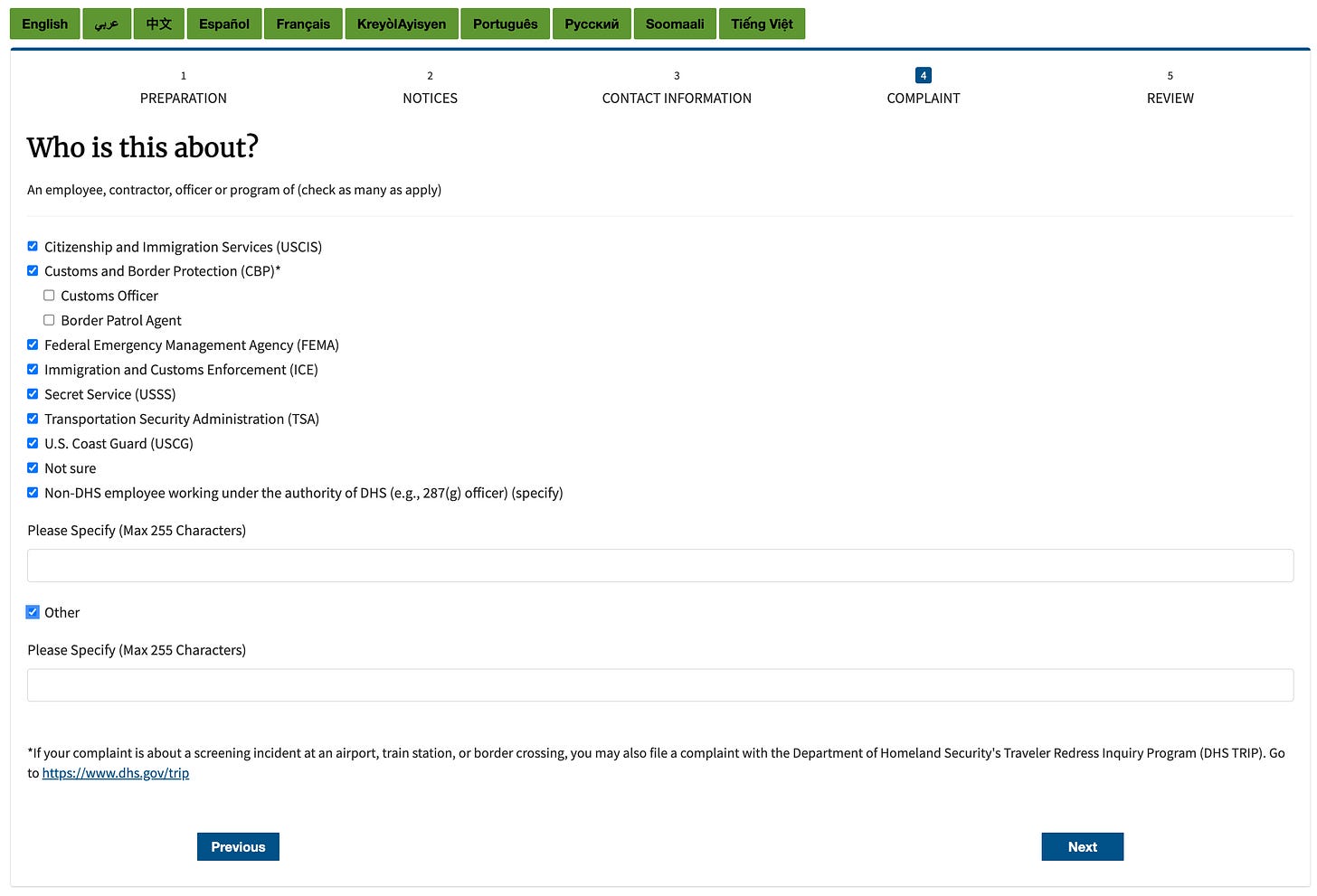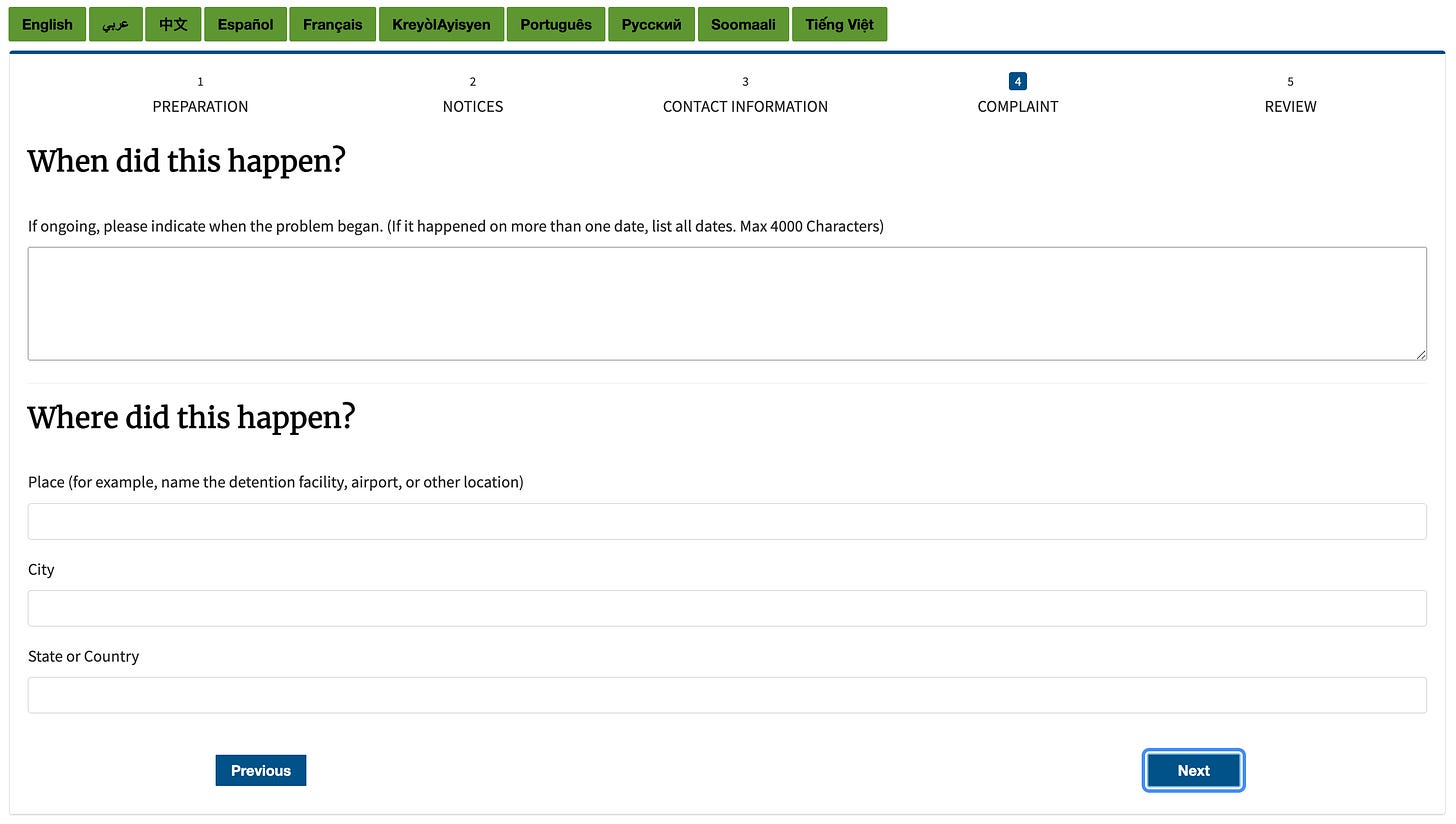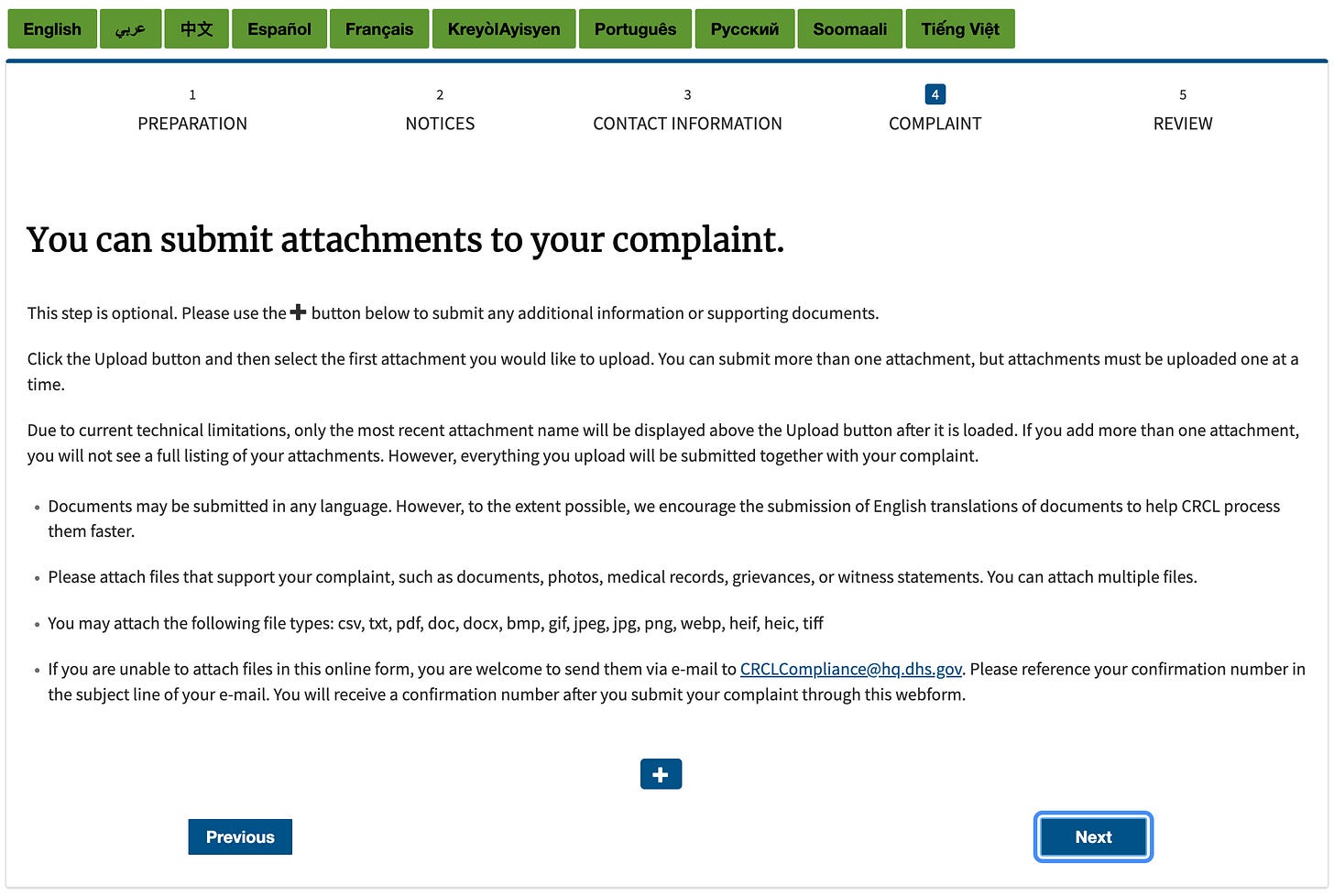Your First Look at the New DHS Portal for Submitting Civil Rights Violations
DHS now lets you fill out civil rights complaints entirely online. Here's exactly what that form looks like from beginning to end.
The U.S. Department of Homeland Security (DHS) Office for Civil Rights and Civil Liberties (CRCL) just released a new online portal that the agency says allows members of the public and immigrant themselves to “submit allegations about possible violations of civil rights, civil liberties, or human rights by DHS programs, activities, personnel, or contractors.”
This could be a step forward in making it easier, and therefore more likely, for legitimate complaints to be submitted. But before we can assess the efficacy of this change, we must first understand how the form works and see what information is collected. In addition, attorneys, advocates, and immigrants themselves will benefit from seeing the entire form before deciding whether to file a complaint or give potential complainants the information they need to have ready before sitting down to file a complaint.
As part of my ongoing research on the digitization of DHS, I went through the form and took screenshots of each page including each conditional field in the report. This is not only important to capture and preserve as research data, but will likely be useful to many others who will benefit from seeing the form before using it.
The images below walk you through the form from beginning to end with comments where appropriate. If you want to see the form for yourself, it is available below.
There are 14 pages. Let’s dive in.
Page 1: Overview and language
The complaint form is offered in 10 languages out of the gate. Not bad. Does anyone know what the CRCL means by “having access to interpreters and translators” that can communicate with people filing complaints? I clicked through to the CRLC’s website but didn’t see any further information about other languages offered.
Page 2: ‘Privacy’ and ‘paperwork reduction’ notices
Some required legalese. I don’t see anything interesting here, although I’m not a lawyer. BFAs (bona fide attorneys, LOL) feel free to comment below.
Page 3: ‘Confidentiality’ notice
Note that complainants can limit how the CRCL uses the information in this form, although the CRCL says that if they can’t use the personally identifying information here, they may not be able to actually conduct an investigation. This is obviously in tension with the next page on retaliation, which one might suspect that different people will interpret with varying levels of trust.
Page 4: ‘Prohibition on retaliation’ notice
Just a simple notice on the prohibition against retaliation. ‘Nuff said, as they used to say in the old Marvel Comics.
Page 5: Are you filling out this form yourself
Note that if you choose “Yes”, the individual information fields on Page 6 will open up here on Page 5.
Page 6: About the Victim
The individual information page is the longest page for reasons that are probably self-evident. Note the form does ask whether the complainant is currently detained and whether the individual is represented by an attorney. I filled in dummy text, but note that actually none of these fields are required.
These two fields—are you in detention? and are you represented?—are optional. If you click on them, the fields you see here will pop down. Otherwise, the user only sees the checkboxes.
Page 7: Who did this to you
This is where the complainant identifies which agency the alleged violating official or officials belong to. It’s a multi-select box, so you can choose more than one. And if you click on “Customs and Border Protection (CBP)”, the options for “Customs Officer” and “Border Patrol Agent” emerge.
I won’t pretend to know more than I do about the various complaint procedures here, but it stands out to me that private contractors are excluded. I’m sure that this is because the CRCL doesn’t have any jurisdiction over those private contractors and that CoreCivic and others have their own complaint procedures. But it is nonetheless worth noting since I’m not sure individual migrants themselves are always going to be cognizant of those kinds of distinctions. (Hell, I doubt most US citizens could tell the difference between any of them.)
Also note that this leaves out the national guard in places like Texas, where Governor Abbott has placed soldiers on the border now for quite some time. In my time in RGV, they were everywhere. Again, I’m not saying that the CRCL can or should have jurisdiction over them, but just illustrating that who is left out might be as important as who is included.
Final note: It is interesting to see 287(g) officers listed here. I had always wondered about that part of the 287(g) memoranda of understanding (Appendix B) that list complaint procedures. Here’s a sample from Knox County, Tennessee (available here).
Page 8: When and where did this happen
Page 9: The One Required Page, WHAT HAPPENED
This is the only page that will not let you proceed unless you fill in any text in the box. I was able to pass this checkpoint by entering just a few characters.
Page 10: Witnesses
This is an important field, obviously. If anyone else saw abuses take place or saw the consequences of abuses take place (i.e. a third party saw signs of physical abuse) the complainant could mention that here. An obvious concern is that people who are potentially undocumented might be understandably reluctant to be named as witnesses, but that’s hardly unique to this context.
Page 11: Additional Notifications
If the individual has, say, notified police or filed a complaint elsewhere, this allows the them to include that information.
Page 12: Other Information
Just another open ended text box.
Page 13: Attachments
This page allows complainants to submit attachments, which I would imagine includes anything from more detailed statements to police reports to images of physical abuse and so on.
Page 14: Final Review of Information
Fairly typical function that allows complainants one last opportunity to review the information they are filing before submitting. I did not click confirm because it appears that this will actually file the information with the agency and I did not want to go that far.
So that’s it, the last page as far as I can tell.
If someone goes further, please save screenshots and share them with me so I can see what happens next, including any confirmation emails, etc.
Support public scholarship.
Thank you for reading. If you would like to support public scholarship and receive this newsletter in your inbox, click below to subscribe for free. And if you find this information useful, consider sharing it online or with friends and colleagues. I maintain a barebones site at austinkocher.com and I share immigration data, news, and research on Mastodon (@austinkocher), Twitter (@ackocher), and Instagram (@austinkocher). You can see my scholarly work on Google Scholar here.





















In February I submitted a complain using this form. To my surprise, I received a response within a week. However ... The response: "After carefully reviewing the information you provided, CRCL has recorded it in our database. This will allow us to track the issues you raised in order to identify potential patterns of civil rights or civil liberties allegations within our jurisdiction. Accordingly, CRCL will take no further action on the information you provided at this time." ... What was my "information? "For months now, Border Patrol has occasionally detained men, women and children outdoors between the wall and the secondary fence at Friendship Park, between Tijuana and Border Field State Park, US.
In one instance, a group was detained 52 consecutive hours, including one night when it rained. They were not provided any protection by Border Patrol. Concerned residents of Playas, Tijuana, provided water, food and blankets.
Once again yesterday, a woman and child were detained outdoors in that area."
By the way, Border Patrol continues to detain people outdoors in the park as contractors build two parallel 30-foot walls through what is considered sacred ground.